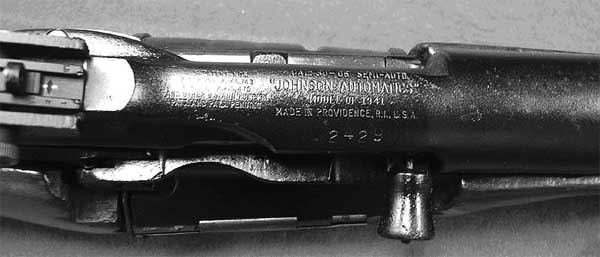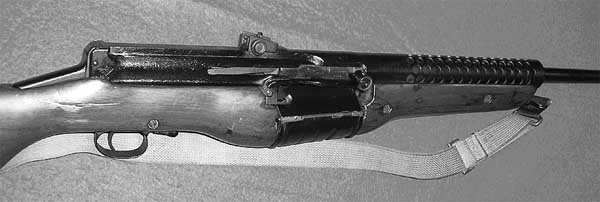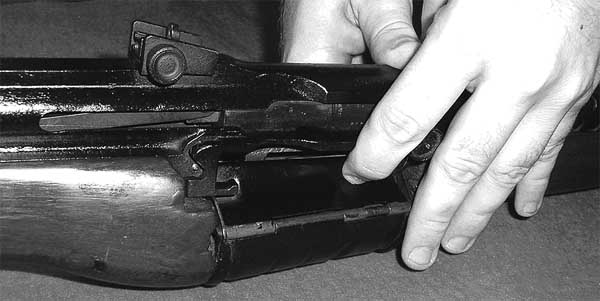The Johnson M.1941 Rifle, Serial # 2429 |
|---|
from the collection of |
Craig Wharton |
Sadly, like all the other 'D' class weapons held on collectors' licence these days, this example is deactivated! The rifle came from a deceased estate so its background history is unfortunately lost. The Johnson is one of those military weapon oddities: a "what if?" It's a firearm that could have been the US Army's standard battle rifle during WWII instead of the Garand. |
 |
During the mid to late 1930s, various countries had experimented with semi-auto rifle designs. In the US, Captain Melvin C. Johnson USMCR, an arms designer, was a Marine Corps observer to Springfield Armouries during the Garand and Pedersen rifle trials. He came to the conclusion that both these designs were flawed and would be difficult to mass-produce, so he set out to design his own rifle. His 1935 prototype was made from scrap firearms parts, and even had a knitting needle for a firing pin! |
By 1938 he had developed his design to the extent that it was ready to submit for US arms trials. Unfortunately it was rejected in early 1940 on the grounds of being too heavy and too long. It also had too many small and easily-lost parts, and being recoil-operated rather than gas, it did not perform well in the accuracy department with the bayonet attached. Later in 1940 Johnson tried again. The new trial was carried out by the USMC, pitting the Johnson against the Garand, and the results were more favourable to Johnson's design. The following year, Johnson released his rifle as the Model 1941. Interestingly the title, Model of 1941, was not a US Military one but was coined by Johnson himself in an effort to 'drum-up business' with the Armed Forces. The US Military had dropped the usage of dates in rifle nomenclature by the late 1920s. Had the Johnson M.1941 been accepted into US service as a supplement to the Garand, or as its replacement, it would have been known as the US Rifle, Calibre .30, M.2. By that stage however, the Garand had already been accepted into service as the US Rifle, Calibre .30, M.1 in 1940. |
 |
In late 1941 the Dutch government placed an order with Johnson for 70,000 rifles to arm its Netherlands East Indies Forces in what is now Indonesia, as invasion by the Japanese forces appeared imminent. During that period, the newly-created USMC Parachute Battalion was also taking a keen interest in the design. Being easily broken down for parachute drops and quick to reassemble it was a good concept. The Johnson's recoil was not as stout as the Garand's, up to 1/3 less in fact (to which the author can attest from past experience!). It also carried 10 rounds in the unique rotary design magazine, which could be reloaded with loose rounds or by 5-round stripper clips to top it back up to 10 at any time. The Garand could not do this as its 8 rounds are held en bloc in a clip. After the 8th round is fired, the empty clip ejects with that distinctive metallic 'ting' sound, a fact that wasn't lost on the Japanese during the Pacific war. That sound was their best chance to jump a G.I. during his reload! |
Some sources claim that the delivery of the Dutch order of 70,000 Johnson rifles was cancelled due to the rapid Japanese advance into the Pacific and the Netherlands East Indies. The author believes some were delivered and on the Japanese invasion of the N.E.I. some were delivered here to arm the free Dutch troops withdrawn to Australia. The author remembers reading somewhere years ago of Australian RAAF personnel being equipped with Johnson rifles here in the Northern Territory, which makes perfect sense as Number 18 Squadron operating out of MacDonald and Batchelor was a mix of RAAF and NEI crews and ground staff. Because of this particular Johnson's low serial number from the first production batch, the author believes it to be one of the rifles either diverted here, or even carried out of Java by an evacuee. |
 |
The NEI order cancellation meant that the USMC then had a ready supply of semi-auto rifles, as all available Garands were given in preference to the US Army and it was late 1942 before the Marines started to receive Garands in any quantity. |
Johnson also designed 2 LMGs: the Model 1941 and Model 1944 LMG. The Johnson M.1941 Rifle and both LMGs were used by Marine raiders and Para-Marines in the Pacific, and by the 1st Special Service Forces in Europe. The Model 1941 was the only recoil-operated rifle manufactured in quantity during WWII, produced from 1941 to 1944 at the Universal Windings Plant at Cranston, Rhode Island. Year of manufacture is indicated by a letter prefix to the serial number. The absence of a letter prefix, as in the current example #2429, indicates 1941 production, the first batch! A 7mm variant was also produced in 1943, to fill an order for 1,000 rifles placed by the Chilean Government for their mounted troops. Production figures for the M.1941 are believed to total about 30,000 units, however actual production is not accurately known as all records were lost during a fire at the factory in 1961. |
The prong bayonet designed for the Johnson, derisively named "the tent-pole bayonet" was short and light-weight, a necessity in order not to interfere with the rifle's recoil system. Considered totally useless by US servicemen who used it, the bayonet is today a very rare and expensive collectable! |
At the end of WWII the USMC returned all M.1941 rifles to the Netherlands Purchasing Commission, although it would appear that the Dutch did not end up with them. In 1953 the Winfield Arms Company purchased all Dutch rifles then held as military surplus in the US, including all parts held in stock by the Numrich Corporation, and shipped the lot to Canada. After refurbishment, Winfield imported them back into the US where they were sold for $70 - $110 depending on their condition. That supply of Johnsons was exhausted by the mid-1960s. |
The last known usage of the Johnson M.1941 on a large scale was during the 1960's attempted invasion of Cuba, during the infamous 'Bay of Pigs' operation. Large quantities of M.1941 rifles and LMGs were used to arm the Cuban exiles who took part in the CIA-backed invasion. |
In a way, the Johnson still lives on! After the war, Melvin C. Johnson worked with Winchester and later with Colt on the Armalite Rifle project. Johnson's patent for the bolt, bolt-carrier, and bolt cam system was incorporated into the M.16 rifle, so his design is still soldiering on. Johnson died in New York on 9th January 1965. His unique rotary magazine rifle design is now a highly sought-after collector's item. |
 |
Having had the privilege of handling and firing both the Johnson and the Garand, as a matter of personal preference the author would prefer the Johnson. US gun-writers often 'wax lyrical' over the virtues of their beloved Garand, ensuring that it always out-performs any 'foreign' opposition during concocted performance evaluations, usually on the basis of national pride! However, sitting in a fox-hole under fire, knowing you have fired 7 rounds but can't top up the magazine until the last cartridge is fired, constitutes a major tactical mistake in firearms design not shared by the Johnson rifle. |
These days, the Johnson has a certain mystique for collectors. It is a real curiosity, a "what if?" ...and this particular rifle is an enigma in its own right: how did it get here? We will probably never know, but perhaps one day some of the answers may come to light. Until then, it will continue to hold a special place in the author's collection as a fine example of one of history's more colourful military rifle developments. |